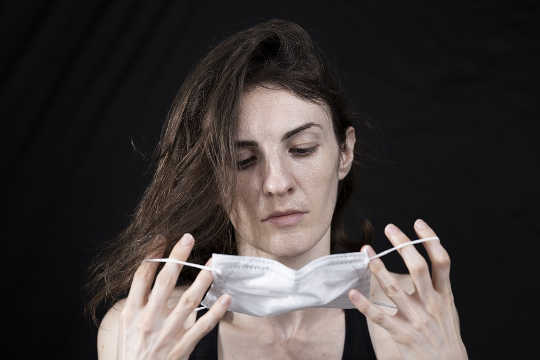
Image by Engin Akyurt
People infected with SARS-CoV-2, the virus that causes COVID-19, can spread the virus when they speak, sing, cough, sneeze or even just breathe. Scientists think face masks help limit virus spread by protecting everyone else from the infected wearer. As a result, face maks are now mandatory in many cities, states and countries to limit the spread of COVID-19.
People typically wear surgical, cloth or other face coverings that don’t completely prevent the virus from infecting the wearer, though medical grade surgical masks do appear to offer more protection. Nonetheless, these don’t have the same level of protection as N95 or P2 “respirator” masks worn by many health-care workers. Additionally, how we wear the mask matters, as touching it often and not completely covering the nose and mouth renders it ineffective.
While these face coverings may not completely prevent us from getting infected with COVID-19, they probably reduce the number of virus particles we inhale — the “viral dose”. Scientists think a lower viral dose can reduce the severity of the disease we get. Indeed, where universal face masking is implemented, a much higher proportion of new infections with COVID-19 are asymptomatic.
Could this lower viral dose help us build some immunity to the disease? Two researchers from the University of California have raised this possibility, writing in the prestigious New England Journal of Medicine. Although the theory hasn’t been proven yet.
Get The Latest By Email
The dose makes the poison
How much virus we are initially infected with is a key determinant of how sick we get, according to evidence from other viruses and animal studies. We also know this is true in hamsters that have been experimentally infected with SARS-CoV-2.
Imagine if you touch a door handle that happens to have one virus particle on it, and then touch your nose and breathe that particle in. You will be infected with that one virus particle. One estimate, published in the Lancet, suggested one SARS-CoV-2 virus particle will have replicated to make nearly 30 new virus particles in 24 hours. Those 30 new particles can then go on to infect 30 more cells, giving rise to 900 new particles in the next 24 hours or so.
Now imagine someone sneezes right in your face and you inhale 1,000 virus particles. After one round of replication you could have 30,000 particles, and then 900,000 in the round after. In the same period of time your body could be dealing with 1,000 times more virus, compared to the first scenario.
How different types of masks work to block droplets from talking, coughing and sneezing (Thorax).
Once the immune system detects the virus, it has to race to get it under control and stop it replicating. It does this in three main ways:
-
telling our cells how to disrupt viral replication
-
making antibodies that recognise and neutralise the virus to stop it infecting more cells
-
making T cells that specifically kill virus-infected cells.
While the first step is relatively quick, creating specific antibodies and T cells takes days or even weeks. Meanwhile, the virus is replicating over and over again. So the initial dose of virus really determines how much of the body the virus has infected before the immune system kicks fully into gear.
What about for long-term immunity?
The more virus there is, the bigger the immune response has to be to control it. And it’s the immune response that actually causes the symptoms, like fever. In an asymptomatic infection, we think the immune system has probably managed to get the virus under control early on, so the immune response itself is possibly smaller, and so we won’t see any symptoms.
We also think many cases of very severe COVID-19 might really be a result of the immune system overreacting. This is why the steroid treatment dexamethasone, which suppresses the immune response, shows promise in treating severe cases (but not mild ones).
After we clear an infection, we keep some immune cells around in case we get infected again. These are B cells, which produce antibodies specific to SARS-CoV-2, and T cells, which kill virus-infected cells. This is also the premise behind vaccination: we can trick the immune system into making those SARS-CoV-2 specific cells without having been infected.
Because face masks might allow a small number of virus particles through, wearers might be more likely to get asymptomatic infections. This might be enough to protect them from future infection with SARS-CoV-2. So if we are in a situation where there is high community transmission, and we can’t always maintain physical distance, wearing a face mask might be a factor that helps us in the long run.
It’s another argument in favour of masks
While this sounds promising, there’s still a lot we don’t understand. We don’t know yet whether an asymptomatic infection would generate enough immunity to guard against future infection — or if this is even measurable.
Viral dose is likely to be just one factor among many that determines how sick someone gets with COVID-19. Other factors include age, sex, and other underlying conditions. Finally, even with asymptomatic infections, we don’t know yet what the long term effects of COVID-19 are. It’s best to avoid getting COVID-19 altogether if possible.
Nevertheless, this is yet another reason to keep wearing face masks. As many cases of COVID-19 are asymptomatic, we could still be transmitting the virus even without symptoms. That’s why wearing a mask is a responsible thing to do, even if we feel fine.
About the Author
Larisa Labzin, Research Fellow, Institute for Molecular Bioscience, The University of Queensland
This article is republished from The Conversation under a Creative Commons license. Read the original article.
books_disease







